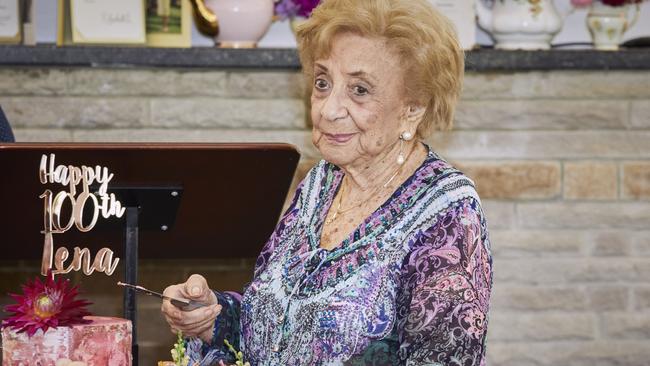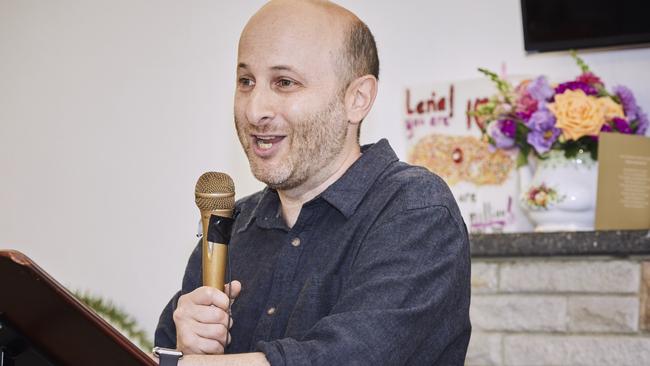Holocaust survivor turns 100, surrounded by love and indelible memories
Lena Goldstein celebrates in the company of fellow Sydneysiders with links to 1940s Warsaw.

In a long life where joy has more than once been overshadowed by loss, Lena Goldstein has known countless examples of what might have been. She was supposed to have become a lawyer, but as a Jewish student in pre-World War II Poland she was prevented from completing her studies. She then enrolled in dentistry in Belgium but the war intervened before she had taken a single class. And from a once vast, extended family, she emerged from that war having lost almost everyone.
But last weekend she experienced the joy that can sometimes come with the unthinkable, as 120 people filled a flower-decked hall in eastern Sydney to mark her 100th birthday.
And gathered at one table, in that room heady with food and love, three generations of another family delighted in the unlikely ties that have bound them to this centenarian Holocaust survivor.
Lena was a 20-year-old student called Chaya Midler when Nazi Germany invaded Poland in September 1939. Confined to the Warsaw Ghetto, where 400,000-plus Jews were forced to live, by early 1943 she was one of just 35,000 still alive. By then, her boyfriend and both her parents were dead, and so was an elderly man who had found refuge with her family, sharing their meagre rations.
All but alone, in April 1943, disguised as a Polish woman on her way to work, she was able to leave the ghetto with the help of two guards. For the next two years, wearing the same blouse and suit all the while, she hid with three others in the darkest recesses of the city.
She had never met Adek Bulkowstein until she saw him in their first place of refuge — a janitor’s bathroom — on that momentous spring day. He had been on one of the first transports to the Treblinka extermination camp in 1942, and while he had been a rare escapee, he could find no trace of his wife Lila or their toddler daughter Malka when he returned to Warsaw. Accused of spreading gruesome propaganda when he tried to warn the ghetto’s Jewish council that the Nazis were not in fact sending Jews away for “resettlement”, he paid a local janitor to hide him, his wife’s niece Hela Lefeld and his brother-in-law Jacob Lauterstein.

When the trio learned that Lena’s family had aided Hela’s ageing grandfather — the old man with whom they had shared their morsels of food — they smuggled a letter to the ghetto offering the young woman a hiding spot if she could escape.
By the time she entered the bathroom, just a day before the Warsaw Ghetto uprising, the three others had already been confined there for months, each with a tiny allocated position. Adek’s spot was in the empty bath where a piece of string around his ankle would be yanked to silence him whenever he cried out from a nightmare. They remained there with Lena, in silent terror, for 18 months until the janitor worried they might be found. Then they spent the next five months beneath a pile of rubble in the city’s sewers.
When they finally resurfaced to a world of utter devastation at the freezing start of 1945, the ties that had bound them through war, hunger and deprivation were not severed. In January 1949, Lena arrived in Sydney with her husband Olek, a survivor of three concentration camps. A year later, Adek and Hela, who were married after the war, followed with their toddler. With their own families obliterated, they had headed to the other end of the world, where the woman who now most seemed like family to them lived.
“Because Lena was here already it was the drawcard,” says Adek and Hela’s only child, Mary Ziegler, who would grow up to consider Lena, her husband and two sons as kin.
“There’s a sense of family without being blood relatives.”
So when Lena reached the once seemingly unattainable age of 100, one of those who rose to toast her longevity last weekend was the grandson of those who had saved her. “From a few survivors crawling out of a sewer … Look where we are now and what has been achieved,” said David Ziegler, surrounded by three generations of Adek and Hela’s descendants, as well as Lena, her sons, daughters-in-law and six grandsons, “thriving, growing bustling families”.
Their story of triumph against terrible odds now spans generations and continents. “Just to live to 100 is an incredible thing,” says David Ziegler. “But to go through all that and then to be there at 100 and for all of us to be there with her … It’s the ultimate definition of survival.”
It can be hard to be among the last survivors. Almost everyone from this unlikely story died long ago. All that remains is the anonymous Warsaw apartment with its bathroom full of secrets, and Lena, who continues to honour her pledge to the janitor never to reveal his name or the place where he had once lived.
Still, turning 100, against so many odds, has proved to be better than she imagined. “I always hated it when people said to me, ‘(I hope you) live to 120’,” she said the morning after her big celebration, referring to the traditional Jewish wish for a long life.
“Because I thought it was a curse.” But despite all she has endured, her centenary celebration was worth waiting for. “I’m glad I got to 100 to see it.”
Lena Goldstein is one of 18 people featured in Fiona Harari’s book We Are Here: Talking with Australia’s Oldest Holocaust Survivors (Scribe).


